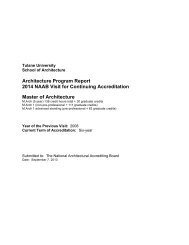Architecture Program Report Tulane University New Orleans ...
Architecture Program Report Tulane University New Orleans ...
Architecture Program Report Tulane University New Orleans ...
Create successful ePaper yourself
Turn your PDF publications into a flip-book with our unique Google optimized e-Paper software.
1. 3 PROGRAM HISTORY<br />
The School of <strong>Architecture</strong>PRIVATE<br />
The <strong>Tulane</strong> <strong>University</strong> School of <strong>Architecture</strong> degree programs address<br />
architecture's primary concerns: creativity, professional responsibility,<br />
technical innovation, and cultural investigations. We offer diverse<br />
programs of academic study and professional preparation within a<br />
context of rigorous scholarship, artistic sensitivity, environmental<br />
awareness, and creative endeavor. The School aims to develop a<br />
student's imaginative and intellectual abilities, and to provide the<br />
information and strategies needed to address contemporary challenges.<br />
The curriculum of the School of <strong>Architecture</strong> centers on the required<br />
design studio sequence, the primary component of each semester of the<br />
ten-semester curriculum. This studio training is coupled with imaginative<br />
and comprehensive instruction in architectural history, theory, technology,<br />
structures, techniques of representation and professional concerns. The<br />
architecture curriculum places emphasis on significant study in the liberal<br />
arts and/or the sciences—for undergraduate and graduate students alike<br />
—by allowing for increased elective course study as the student<br />
progresses. All coursework emphasizes a variety of theories, points of<br />
view, methods, and goals. As such, the responsibility of the faculty and<br />
administration of the School of <strong>Architecture</strong> is not only to enable a<br />
student's development as an architect; but also to further the discourse<br />
of the discipline and engage the contemporary cultural context. At the<br />
same time, the School of <strong>Architecture</strong> seeks the discovery of new<br />
knowledge by approaching the outermost parameters of both the<br />
discipline and practice of architecture.<br />
History of the <strong>Tulane</strong> School of <strong>Architecture</strong><br />
The first courses in architecture at <strong>Tulane</strong> <strong>University</strong> leading to a degree<br />
in architectural engineering were offered in 1894 under the direction of<br />
Professor William Woodward. An article published in 1907 noted, “the<br />
geographical location of the city of <strong>New</strong> <strong>Orleans</strong>, its cosmopolitan<br />
character, and the age and variety of its unique building types, make it a<br />
fit place in which to develop a school of architecture which would be<br />
suited to its environment, maintain a reasonableness of planning and<br />
construction, and be recognized as appropriate to the climatic<br />
conditions.” Accordingly, a full four-year professional curriculum in<br />
architecture, leading to the Bachelor’s degree, was established in the<br />
College of Technology (Engineering) in the academic year 1907-1908. At<br />
that time Samuel S. Labouisse, Moise H. Goldstein, and Allison Owen<br />
joined the staff. In 1912, Professor Nathaniel Cortlandt Curtis was<br />
appointed head of the newly independent <strong>Architecture</strong> Department; he<br />
was succeeded by Professor John Herndon Thompson in 1921 and<br />
Professor Buford L. Pickens in 1946. At the conclusion of the Second<br />
World War, the faculty and enrollment increased to accommodate<br />
returning veterans, and the school continued to grow throughout the next<br />
two decades. John Ekin Dinwiddie was appointed dean of the School of














